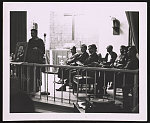Driving Miss Jane Pittman: The Issues of Race and Class in the Novel
By Tre' Knapp
In the century between the Civil War and the Civil Rights Movement, the economic system of the South underwent significant upheaval. The Autobiography of Miss Jane Pittman allows Ernest Gaines to explore the changes to this economic system and the social superstructure—the laws, literature, social mores, and cultural values—that it supported. Gaines’s own history, and the circumstances in America during the time he began writing the novel, drove his motivation and are mirrored by the events, both real and fictional, that he included within its pages. Southern history as experienced by Jane Pittman is the story of elite white landowners desperate to retain control of the means of production in the wake of the loss of slavery, and how these landowners established a new social superstructure to ensure the continued subjugation of black Americans despite their legally free status. Gaines depicts this struggle through a Southern Gothic aesthetic, emphasizing the psychological horror and collective scars that the history of slavery, discrimination, and white supremacy have left on Southern society.
Gaines does this primarily through the lives and deaths of three characters: Tee Bob, Ned, and Jimmy. Though this novel is about the history and horror experienced by the black community as represented by Jane Pittman, Gaines uses a white character, Tee Bob, to most exemplify the psychological horror typical of the Southern Gothic aesthetic. At this point in the novel, neatly between the stories of Ned and Jimmy, Reconstruction has passed, and Jim Crow has been firmly established, ushering in the new social superstructure to maintain white supremacy in the South. Other characters are either able to internalize this superstructure and live under the new rules, or actively fight to change them. For Tee Bob, this superstructure can neither be internalized nor changed, leaving him helpless to the cumulative horrors of the rules his society has established. He can neither understand why his friend and brother Timmy is forced to leave the plantation, nor why he cannot have a relationship with the schoolteacher Mary Agnes. As Jules Raynard reveals to Jane after Tee Bob’s suicide,
Somewhere in the past … way, way back, men like Robert could love women like Mary Agnes. But somewhere along the way somebody wrote a new set of rules condemning all that. I had to live by them, Robert at that house now had to live by them, and Clarence Caya had to live by them. Clarence Caya told Jimmy to live by them, and Jimmy obeyed. But Tee Bob couldn’t obey. That’s why we got rid of him. All us. Me, you, the girl—all us.
Earlier drafts of the novel include the full letter or direct references to its content, but in the final published version, the contents of the letter are omitted and only referred to obliquely. Preserving the mystery of the depth of Tee Bob’s horror and despair and replacing it with Raynard’s explanation of the horrific suicide of Tee Bob lays out the essence of Southern Gothic—the psychological horror buried deep in the culture due to its history—in plain text.
Gaines began writing The Autobiography of Miss Jane Pittman in San Francisco in 1969, at the tail end of a decade that had seen the assassinations of dozens of civil rights activists, and only one year after the assassination of Martin Luther King, Jr. Though Gaines certainly sat down to write a more authentic neo-slave narrative than William Styron’s controversial work, the deaths of Black civil rights leaders must have also weighed on his mind, and this is evident in the thrust of the novel, as it quickly turns from the early life of Miss Jane Pittman to her role in raising two budding civil rights leaders in her community—Ned and Jimmy—both of whom die at the hands of white supremacy.
The two young boys raised by Jane over the course of the book, not coincidentally, grow up to be leaders of their communities. Ned returns to Louisiana from his travels at the turn of the century to build a school on the plantation in Book II, while Jimmy leads the local civil rights struggle in the 1960’s at the climax of the novel. Raised by the fiery Jane, neither man is capable of simply internalizing the white supremacist superstructure of Southern society. They believe in the promises of the end of the Civil War and Reconstruction—that black Americans deserve and can have better lives. For having the audacity to stand against white supremacy, both men were murdered. For wanting to build a school to educate his community, Ned was gunned down by Albert Cluveau. For wanting a better bathroom to use, Jimmy was shot in Bayonne. Both of these men mirror the lives, actions, beliefs, and deaths of real civil rights leaders. Gaines even directly names some of their influences in the novel: Booker T. Washington and Frederick Douglass by Ned, and Martin Luther King, Jr. and Rosa Parks by Jimmy.
The deaths of Ned and Jimmy at the hands of a white supremacist superstructure, over six decades apart from each other, depict a kind of hopelessness in the tone of the novel. Though separated by more than half of Jane’s life, their deaths illustrate that nothing had changed. In fact, if anything, the superstructure assuring white supremacy had strengthened over the intervening sixty years. Albert Cluveau ambushed Ned and two black witnesses simply weren’t believed, but Jimmy was gunned down in broad daylight in town.
There is, however, nuance in this feeling of hopelessness. Both men acted, to some extent, contrary to their community, as represented by Jane. Jane more directly confronted Ned, begging him to stop what he was doing and run from death, and he refused. Jimmy was able to convince her to act, but it took some effort and she worried for him, nonetheless. In the wake of their deaths, it is the community coming together that leads to success, and this tempers the hopelessness by sharing the burden. After Ned dies, Jane explains, “The people finished the school … but it was destroyed in the second high water. That was back in ’27 when we had a very bad high water.” After hearing news of Jimmy’s murder, the novel ends with Jane continuing to lead her community to the protest in spite of the loss, with Jane declaring, “Just a little piece of him is dead … The rest of him is waiting for us in Bayonne.” This collectivization of social labor after each man’s death—the coming together of the community—provides the answer to the horrors of the white supremacist superstructure present in the South, both over the course of Jane’s life and to Gaines’ readers in the early 1970’s.
Though the novel is presented as an autobiography, Gaines presents the Southern Gothic horror of white supremacy through multiple perspectives and eras. In Tee Bob, he depicts how nobody escapes the clutches of the superstructure. Through Ned, Gaines illustrates a hopelessness in the promises of the dominant culture. With Jimmy, the way to defeat the superstructure—collectivization and community—begin to become apparent. And Miss Jane Pittman ties it all together over the course of her century, leaving the reader at the open end of the novel with the question: Where do we go from here?




